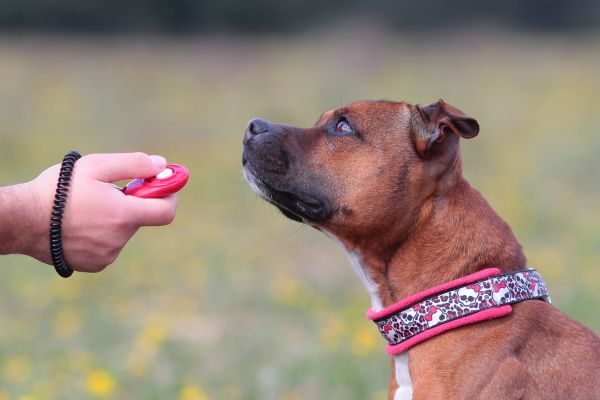If you’ve ever wondered why some dogs (and even cats, believe it or not) seem to pick up tricks so quickly, the secret often comes down to something simple: clicker training. It’s one of those methods that feels almost too easy at first glance, but once you dive in, you realize how powerful it can be. Let’s talk about clicker training basics, what makes it work, and how you can use it to strengthen the bond between you and your pet.
What Is Clicker Training?
At its core, clicker training is a form of positive reinforcement. You’ve probably seen those small handheld devices that make a distinct “click” sound when pressed. That’s the clicker. The idea is to use that sound to mark the exact moment your pet does something you want them to repeat. The click is followed by a reward—usually a treat, sometimes praise or playtime. Over time, your pet learns that the click means, “Yes! You got it right.”
The cool part? The click is clear, quick, and consistent. Unlike your voice, which can sound different depending on your mood, the clicker is always the same. That consistency makes it easier for animals to understand exactly what behavior earned the reward.
Why Clicker Training Works So Well
Here’s the thing: animals thrive on clarity. When training, they don’t always understand human language, but they do understand timing. If you wait even a second too long before giving a treat, your pet might associate the reward with the wrong action. That’s where clicker training basics shine. The sound bridges the gap between the behavior and the reward.
Think of it like taking a snapshot of the moment. The click is instant—like a photo capturing the exact behavior you want. Then the treat reinforces it. Simple, but effective.
Getting Started with Clicker Training
So, how do you actually begin? It’s easier than you might think.
First, you need to “charge” the clicker. That means teaching your pet that the sound equals something good. You do this by clicking and immediately giving a treat, over and over. No tricks required yet. After a few sessions, most pets start perking up the second they hear the click.
Once your pet makes the connection, you can start using it for specific behaviors. For example, ask your dog to sit. The moment their bottom touches the floor, click and treat. Do this consistently, and soon enough, they’ll start sitting faster, waiting for that click.
Timing Is Everything
If you take away only one thing from these clicker training basics, let it be this: timing is the secret sauce. A mistimed click can confuse your pet and slow down progress. That’s why it helps to keep sessions short and stay focused. Five minutes of sharp, clear training beats half an hour of sloppy timing any day.
Common Mistakes to Avoid
Even though clicker training is straightforward, there are a few traps new trainers fall into.
One big mistake is overusing the clicker. Remember, the click isn’t a toy—it’s a tool. If you’re clicking at random times, your pet will stop taking it seriously. Another common slip is forgetting to follow the click with a reward. No matter how small the treat, it’s the reinforcement that makes the click meaningful.
And let’s be real, patience is everything. Pets don’t learn overnight. If you get frustrated, they’ll sense it. Keeping sessions light and fun makes the process smoother for everyone involved.
Expanding Beyond Basic Commands
Once you’ve nailed the sit, stay, or lie down, you can get creative. Clicker training basics aren’t limited to just obedience. You can use it to teach fun tricks like spinning, shaking paws, or even fetching specific items. Some owners use it for behavior modification too—like helping nervous pets feel calmer around new people or environments.
The beauty of clicker training is its flexibility. Whether you’re working on everyday manners or circus-worthy stunts, the same principles apply.
Clicker Training for Different Pets
Most people think of dogs when they hear about clicker training, but cats, rabbits, birds, and even horses can respond to it. The key is adjusting rewards based on what motivates your animal. Dogs are usually food-driven, while cats might prefer a mix of treats and play. Birds often respond to seeds or attention. The basics don’t change—you just tweak the delivery.
Keeping It Fun and Engaging
At the end of the day, training should feel like a game, not a chore. Short, upbeat sessions keep your pet engaged and excited. Try mixing training into daily routines. For example, ask for a sit before mealtime or a high-five before heading out for a walk. That way, training doesn’t feel like an extra task; it becomes part of everyday life.
The Human Side of Clicker Training
Here’s something people don’t talk about enough: clicker training isn’t just about teaching your pet—it also teaches you. You become more observant, more patient, and more tuned into your animal’s body language. You start noticing those little cues that tell you your pet is thinking, trying, or even about to succeed. That awareness builds a stronger bond than any command ever could.
Wrapping It Up
Clicker training basics might sound simple, but don’t underestimate them. With a small device, some treats, and a bit of patience, you can unlock a whole new level of communication with your pet. The click becomes more than just a sound—it’s a language you both understand. And honestly, that’s what makes it magical.
So grab a clicker, a pocketful of treats, and give it a shot. Chances are, you’ll be surprised at how quickly your pet catches on—and how much fun you’ll both have along the way.

